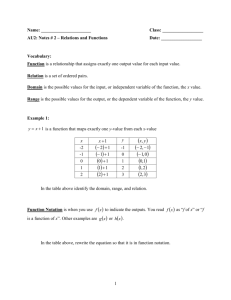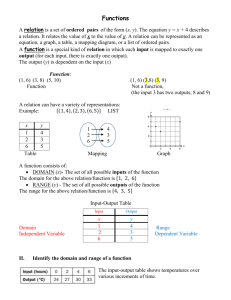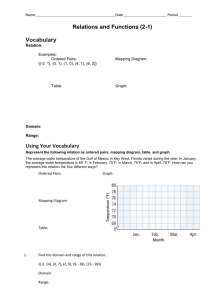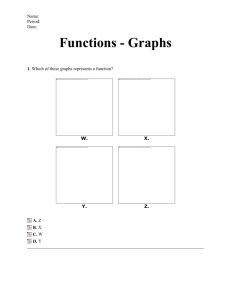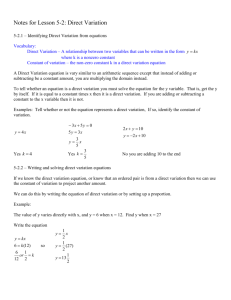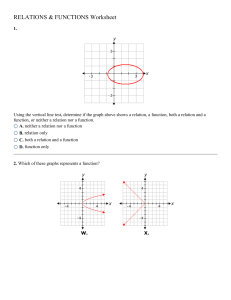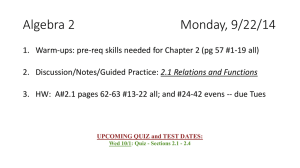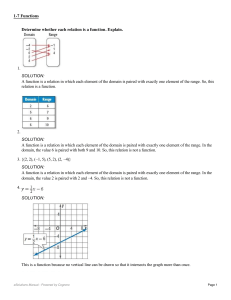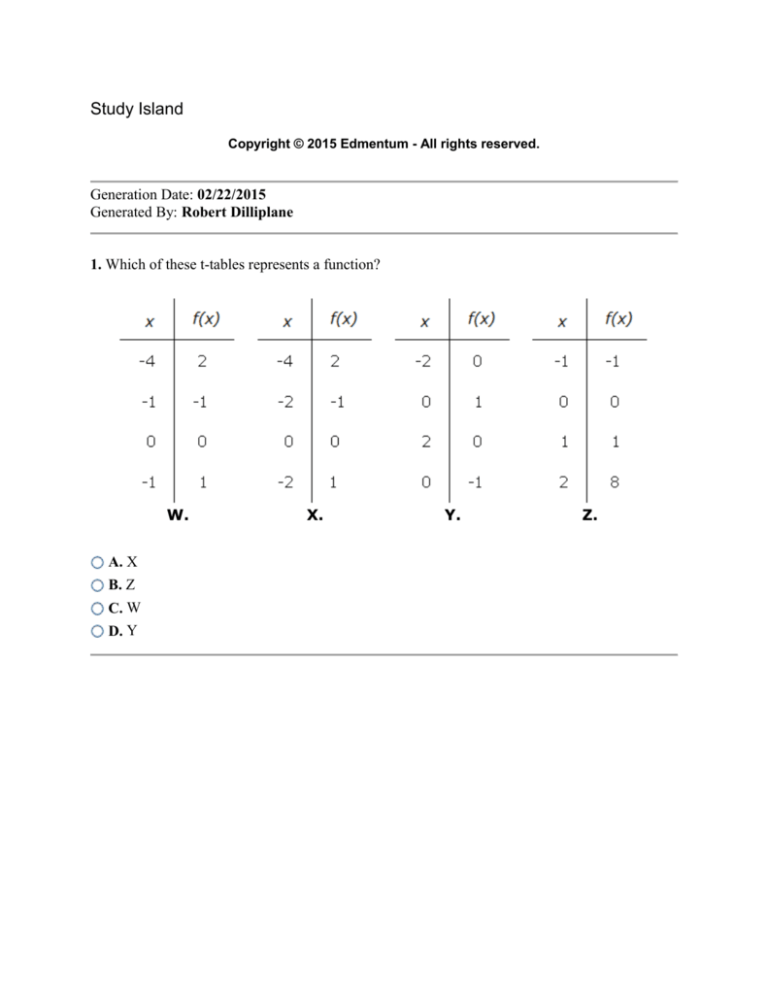
Study Island
Copyright © 2015 Edmentum - All rights reserved.
Generation Date: 02/22/2015
Generated By: Robert Dilliplane
1. Which of these t-tables represents a function?
W.
A. X
B. Z
C. W
D. Y
X.
Y.
Z.
2.
Using the vertical line test, determine if the graph above shows a relation, a function, both a
relation and a function, or neither a relation nor a function.
A. neither a relation nor a function
B. relation only
C. both a relation and a function
D. function only
3. Which of these mappings is a function?
W.
A. W
B. Z
C. X
D. Y
X.
Y.
Z.
4. Which of the following relations describes a function?
A.
B.
C.
D.
{ (2, -2), (0, 0), (2, 2), (3, 3) }
{ (-3, 9), (-2, 4), (2, 4), (3, 9) }
{ (9, -3), (4, -2), (4, 2), (9, 3) }
{ (-2, 0), (0, 2), (2, 0), (0, -2) }
5. Which relation diagram represents a function?
A. Z
B. Y
C. X
D. W
W.
X.
Y.
Z.
6. Which of the following tables represents a function?
x -10 -6
0
2
A.
y 17 15 23 17
x -10 -6
0
0
B.
y 17 15 17 16
x -10 -6
0
-6
C.
y 17 15 17 16
x -10 -6 -10
2
D.
y 17 17 23 16
7.
Does the graph above show a relation, a function, both a relation and a function, or neither a
relation nor a function?
A. neither a relation nor a function
B. both a relation and a function
C. relation only
D. function only
8. Which of these mappings is a function?
W.
A. Y
B. W
C. Z
D. X
X.
Y.
Z.
9. Which of the following graphs is not a function?
A. W
B. Y
C. X
D. Z
W.
X.
Y.
Z.
10. Which of the following relations describes a function?
A.
B.
C.
D.
{ (-2, 0), (0, -2), (0, 2), (2, 0) }
{ (0, 0), (2, -2), (2, 2), (3, 3) }
{ (3, 3), (3, 4), (3, 5), (3, 6) }
{ (2, 3), (3, 3), (4, 3), (5, 3) }
Answers
1. B
2. B
3. B
4. B
5. C
6. A
7. C
8. D
9. B
10. D
Explanations
1. A function maps each domain element to only one range element.
The t-table Z is the only table that does not show a domain element paired with two or more
range elements.
2. A relation is a set of one or more ordered pairs.
A function is a relation in which each element of the domain is paired with EXACTLY one
element of the range.
The Vertical-Line Test: Given the graph of a relation, if a vertical line can be drawn that does not
cross any of the graphs in more than one place, it is a function.
Any vertical line drawn between x = 0 and x = 6.5 will cross the graph in more than one place.
Therefore, the graph is not a function, and it is a relation only.
3. A function maps each domain element to only one range element.
The only mapping that does not map a domain element to two or more range elements is Z.
4. A function is a set of ordered pairs such that for each domain element there is only one range
element.
The set of ordered pairs { (-3, 9), (-2, 4), (2, 4), (3, 9) } is the only set that does not pair a domain
element with two or more range elements.
5. For a relation to be a function, each input value can only correspond to one output value. The
relation diagram where each input value has exactly one arrow drawn to an output value will
represent a function.
Therefore, diagram X represents a function.
6. A relation is a set of one or more ordered pairs.
A function is a relation in which each element of the domain is paired with EXACTLY one
element of the range.
In other words, a function does not have two or more y-coordinates for any x-coordinate, which
is shown in the table below.
x
-10
-6
0
2
y
17
15
23
17
7. A relation is a set of one or more ordered pairs.
A function is a relation in which each element of the domain is paired with EXACTLY one
element of the range.
In this case, there are two y-coordinates for every x-coordinate between -2 and 1.
Therefore, it is a relation only.
8. A function maps each domain element to only one range element.
The only mapping that does not map a domain element to two or more range elements is X.
9. A relation is a set of one or more ordered pairs.
A function is a relation in which each element of the domain is paired with EXACTLY one
element of the range.
The Vertical Line Test: Given the graph of a relation, if a vertical line can be drawn that crosses
the graph in more than one place, then the relation is not a function.
Therefore, graph Y is not a function.
10. A function is a set of ordered pairs such that for each domain element there is only one range
element.
The set of ordered pairs { (2, 3), (3, 3), (4, 3), (5, 3) } is the only set that does not pair a domain
element with two or more range elements.



